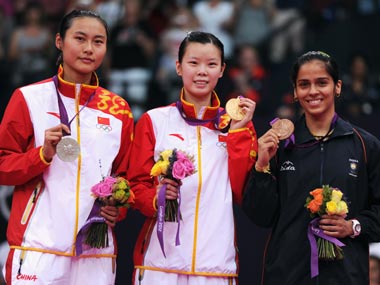This is Part-I of a five-part series on Indian badminton which includes interviews with P Gopichand and India’s badminton stars. Click here for Part-II of the interview , which is on Gopichand’s quest that keeps him awake at night — the quest for the next Gopichand.
It seems that the Pullela Gopichand Badminton Academy is made of just two colours — the brilliant inviting green of the playing field on the outside and the staid light green on the inside of the badminton courts — muddled with the brown flooring.
The smell of sweat, rubber and air-freshener overwhelms as you enter the arena at 7 AM — but the floor full of players buzzing ahead of their first training session (they train in batches, with breaks), makes your forget everything else.
Gopichand is himself in shorts and tshirt watching the proceedings. The place is chugging away with meticulous precision, players’ eyes flitting towards ‘Gopi Sir’ — whether he’s seeing them or not — whether or not he thinks they’re the next big thing in the sport. There is fun, but there is a heavy seriousness to it all.
Even though the walls are plain — incredibly plain — the writing on them is clear — you have to beat China. This is an operation which is headed towards that ultimate objective.
India’s top ranked badminton player Saina Nehwal has played a Chinese player 58 times in her career. Out of these 58 games, she has won just 21. In men’s badminton, top ranked P Kashyap has won just four times against a Chinese opponent — losing on the other 18 occasions.
The other two men in the world top 25, RMV Gurusaidutt (24th) has lost seven of his eight and Ajay Jayaram (25th) has lost 12 of his 13 matches against Chinese opponents.
PV Sindhu, ranked 10th in the world, has in her fledgling career, fared slightly better — losing eight and winning eight of 16 matches she’s played against the Chinese.
While there are five Indians in the top 25 of the world in men’s and women’s badminton, China has seven. But these seven are all in the top 10. In short, if you want to do well in badminton, you have to beat China.
But there’s been a recent surge with other Asian countries rising in the sport. It’s a gradual shift, very slow and needs meticulous planning — but it’s happening. However, Gopichand is too cautious to acknowledge it wholeheartedly.
“I think so too but it’s a little early to say it loudly. But yes, I think Thailand, Japan, India and Chinese Taipei have come into the frame in the last few years,” he tells us before issuing a warning, “We cannot underestimate the power of the Chinese system because if they figure it out, they replicate it very fast so you might have a group of players come in suddenly and then we could be in for a challenge again.”
While India’s badminton programme is not scoffed at in the the badminton world anymore, it still goes into a match against China as underdogs. Their success rate is phenomenal — 16 gold, eight silver and 14 bronze medals at the Olympics. At the 2012 Olympics, for instance, China won all five gold medals , two silvers and a bronze. It was way back in 1996 that they failed to win a singles gold at the Olympics.
So, what are they doing that India isn’t?
“We have a one, two or three places (academies), they have a hundred. So the numbers are huge, the investment is huge and especially with China, their discipline is enforced. So they just have….” Gopichand draws in a breath here, “… more. They are ruthless, so the results come.”
And there cannot be a more glaring example of this ‘ruthlessness’ than what Chinese diver Wu Minxia had to go through at the Olympics in London. She won the gold medal for her country, but the news of her grandmother’s death was kept from her for years along with the fact that her mother was battling breast cancer — all because such news would affect her performance.
Despite confidently claiming that this generation of badminton players is not ‘soft’, it’s clear that such an enforcement programme would be met with cries of foul rather than cheers in India.
Gopichand’s assessment couldn’t be simpler. The sheer numbers in the Chinese badminton setup means that when they’re competing among themselves, they’re competing against the best. Also, the government supports the players — they dont’ have to rely on federations, academies and petty politics to make it to the top. Their qualification process, usually based on rankings and form, is heavily played up in media.
When you chat with Gopichand about badminton, China inadvertently comes up. And that’s because one of the toughest steps towards an Olympic medal is beating China. And these things don’t happen overnight, it takes meticulous planning, and Gopichand admits that he’s put together specific plans at times — however, the challenge is greater than just one nation.
“If you see Saina winning — then obviously you can see that over the years we’ve been planning for China because they were No 1. But today, we don’t look at it just that way because there are others to beat as well and we look at all of them together. So now, it’s not just China — whoever is at the top, you want to target.”
Malaysian Lee Chong Wei is world No 1 while players from Thailand, Indonesia, Vietnam, Japan, Hong Kong, Korea and Chinese Taipei feature in the top 25. Denmark, Spain and Germany are only the European countries featuring in these.
It may sound harsh, but it’s no secret that China figuratively manufactures athletes when they decide to win big — and they’ve chosen their sports and outperformed the world at the top level. Table-tennis, gymnastics, badminton and diving have brought in 212 of their 473 total Summer Olympics medals.
Which brings us back to how Gopichand spoke of ‘replication’. China, just like in any other sport, has created a prototype of a badminton player — fast, fit, agile and most of all, tactically clever and scheming. Add to that the eccentric genius of players like Lin Dan.
India on the other hand, is still forming a distinctive style: “With China it’s a factory lineup. Most of their players are all the same when it comes to playing style. But India is still evolving it’s badminton style. We’ve had strokeplay, we’ve had power and the new generation is a mixture of both. But our players are all aggressive, rely a lot on the smash and spend a lot of energy. But we’ve had varied kind of players because of our physiques in the sense — you have a Sindhu who’s six feet and then you have a Saina who’s 5'6”.
“In the men also, we have different people, different styles and different body frames — so to brand India’s as one particular game style would be difficult. Whereas Chinese — all of them are the same so they play the same game and their role models are also the same. India is not like that.”
Gopichand himself has a comparatively good record against Chinese opponents — played 28, lost 15, won 13. And while he acknowledges the emergence of other countries, there’s no hiding from the fact that China are the ultimate opponents.
Click here to read Part-II of the interview, where Gopichand reveals what wakes him up at 4 AM everyday.
You can follow the writer on Twitter @TheFalseNo9

)




)
)
)
)
)
)
)
)